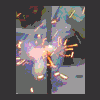Is there an easy way to make E-matches?
#1

Posted 30 April 2009 - 08:15 PM
I've got (I think) all the supplies, but the nichrome wire is so thin that it is very hard to work with. Any tricks to getting wires attached to the nichrome? The wire I have is 48 guage... like thin hair.
Thanks for any info!
(Lev 2:9)
--seems to me that if God likes the odor of burnt cereal, He's just gotta love gunpowder...
#2

Posted 30 April 2009 - 08:30 PM
Only bakers fluid active flux is suitable for soldering nichrome.
Edited by Arthur Brown, 30 April 2009 - 08:31 PM.
Keep mannequins and watermelons away from fireworks..they always get hurt..
#3

Posted 30 April 2009 - 08:55 PM
Cooperman's way is easy and reliable, i can't find the link atm can someone add one if its still available?
Edited by Sambo, 30 April 2009 - 08:59 PM.
#4

Posted 30 April 2009 - 10:50 PM
Link to my old site. Ematches are on there so dont follow the link to the new website but go to Projects then Pyro build Projects and then Ematches.
Click here for Cooperman435, THE online shop for chemicals, materials and tooling
Click here to email me Personally,
Click here to email Optimum Fireworks, West Yorkshire's premium Display Company
#5

Posted 01 May 2009 - 01:06 AM
#6

Posted 01 May 2009 - 08:14 AM
Dont forget that your not actually twisting the nichrome round the wires but twisting the wires and holding the nichrome stationary.
Theres a video to watch too of the whole process. 30 seconds long.
Click here for Cooperman435, THE online shop for chemicals, materials and tooling
Click here to email me Personally,
Click here to email Optimum Fireworks, West Yorkshire's premium Display Company
#7

Posted 01 May 2009 - 08:53 AM
#8

Posted 01 May 2009 - 09:36 AM
Coopermans method works fine - the only possible downside that has been mentioned is that because the wire is wrapped and not soldered it's possible corrosion could set in in storage - only time will tell on this one.
 thegreenman
thegreenman
#9

Posted 01 May 2009 - 10:05 AM
I must be doing something wrong, because I have some of the ODA chips (the ones with the thinner wire) and there is no way I can get them to ignite even the most sensitive pyrogen.
There are a couple of tricks with the #50 gauge ODA chips. You do indeed need a very sensitive pyrogen. I use 50/50 potassium chlorate and antimony trisulfide. The ingredients must pass 200-mesh and should be mixed wet in ping-pong laquer. The camphor plasticister in the ping-pong celluloid tends to help the matches burn rather than shatter.
Once you have this primer layer in place, it's easy to coat over with BP/NC or H4/NC and then a clear layer of laquer. With the correct recipe, you can have 100% success with these chips. They're compatible with commercial matches (ie 1.5 ohms, 0.5A current) and will fire from a single AAA cell. I've stored a few for over a year and they still seem reliable.
Edited by BrightStar, 01 May 2009 - 12:29 PM.
#10

Posted 01 May 2009 - 11:22 AM
I think the problem could be that my chemicals are not fine enough. Otherwise, I'm pretty much following your method.
I did buy the 50g version for the very reason that they would be equivalent to commercial ematches. If I can get them going, they will work out at about 8p each, which is pretty good. Otherwise I have 1000 very small white elephants!
 thegreenman
thegreenman
#11

Posted 01 May 2009 - 06:20 PM
Keep mannequins and watermelons away from fireworks..they always get hurt..
#12

Posted 02 May 2009 - 05:14 PM
Seems entirely down (as you said) to the fineness of the grind. Put both chems in my mill for a couple of hours (NOT together for those new to this) bound with my usual NC and three out of three successes - as opposed to 0 out of 30 previously.
Will now do a bit larger trial to test relibility, no fire currecnt etc...
Many thanks.
 thegreenman
thegreenman
#13

Posted 02 May 2009 - 05:43 PM
It works!
Damn it... I was hoping to take some of those 'little white elephants' off you at a discount
Given the excuse, I popped some of my original matches - 2 1/2 years old stored with silica gel. No problems at all - a healthy crack and jet of sparks from each one. These were chlorate primer/NC + BP/NC + clear laquer.
Now we just have to make some protective covers. Any ideas?
#14

Posted 02 May 2009 - 05:47 PM
#15

Posted 04 May 2009 - 12:51 PM
1 user(s) are reading this topic
0 members, 1 guests, 0 anonymous users
















